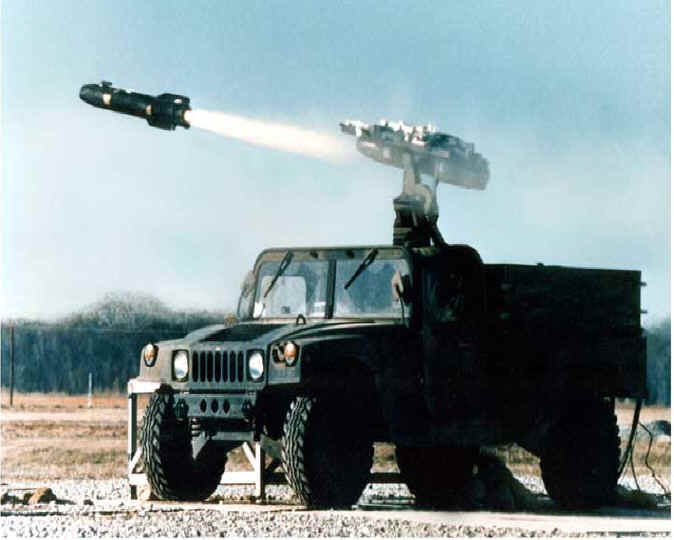The TOW anti-tank guided missile is good, but the Hellfire is superior since it has twice the range, twice the warhead, and impacts at supersonic speeds. It doesn't require the gunner to sit still and track the missile to its target after the launch blast reveals his location. Hellfires guided by optical cameras, lasers, or infra-red seekers proved lethal when fired from attack helicopters during the 1991 Persian Gulf war. A ground-launched version has already been developed and mounted on the HMMWV in four-missile pods.

Hellfire II - The Ultimate Light Anti-Tank Weapons System
Using a laser designator, a HMMWV can launch all four of its Hellfires a few seconds apart at a tank platoon up to 5 miles away. As each Hellfire slams into a tank, the gunner moves the laser "spot" to the next tank, so each tank blows up a few seconds apart. Attack helicopters could also be downed with ground-launched Hellfires. Finally, Hellfires provide a powerful bunker-busting capability. These missiles are expensive ($100,000 each), but stationary ground vehicles should prove more accurate guided missile platforms than moving multi-million dollar helicopters which can be shot down.
This modification would cost almost nothing. However, enthusiasm for this idea may be lacking among tankers and chopper pilots. If the FIST-V can fire missiles, expensive attack helicopters are less vital. In addition, a FIST-V with Hellfires could foul up war games since it could knock out several tanks before tanks were in range to return fire. Tankers may argue that even a 100 lbs supersonic missile cannot penetrate modern fontal armor of a heavy tank. This may be true, but the impact would certainly damage the gun, optics, electronics, and crewmen.
Hellfires should also replace most wire-guided TOW systems. Helicopters have already proven the value of Hellfires and they are available for procurement. Amazingly, American ground combat forces have shown no interest in Hellfires. The basic criticism is that a Hellfire must fly 200-300 meters before it arms itself. This provides a huge safety margin for attack helicopters, but this could be cut in half for ground launched versions.
Carlton Meyer editorG2mil@Gmail.com
Letters
Heavy Hellfires
"Each Hellfire weighs only a hundred pounds" Oh, that's all? Sorry sir, but you're wrong on this one. You have obviously never had the pleasure of reloading a TOW round from inside a Bradley or ITV. The BGM-71 TOW missile weighs from 54.2 to 64.1 lbs depending on the round used. We would never get any $100,000 Hellfire rounds for live fire training. Mount them on the M981 FIST-V? We already have a vehicle for that. It's called the M901 ITV. You should take a look at the Javelin ATGM that the Army is field testing. Unfortunately only the great and all-powerful 82nd ABN division gets to play with the Javelin. At least it's light enough to be man portable like the M47 Dragon (crap!).
One old TOW SGT